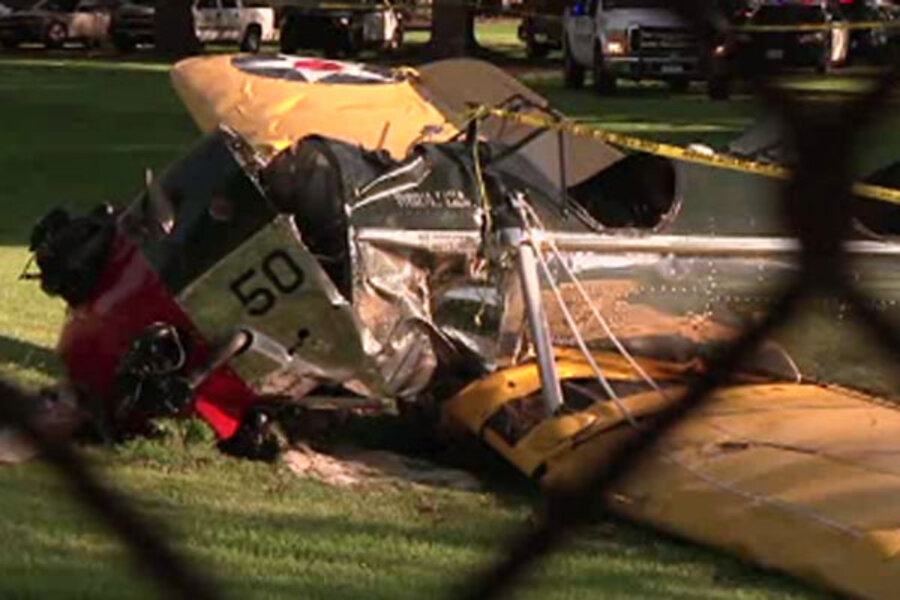Harrison Ford's love of flying tested before latest incident
Loading...
| Los Angeles
When a man battles Darth Vader, Nazis and other evil-doers for work, what does he do for fun? Harrison Ford finds his answer in a pilot's license and the freedom to take to the skies.
But with adventure comes risk, just as Han Solo, Indiana Jones and other daring movie characters Ford brought to life realized. On Thursday, one of Hollywood's pre-eminent stars added a plane crash to an aviation record that includes both mishaps and service to others.
Ford, 72, who battled Hitler's henchmen in "Raiders of the Lost Ark" as dashing archaeologist Jones, was flying a World War II-era plane when it lost engine power shortly after takeoff from Santa Monica Municipal Airport near Los Angeles. He crash-landed the plane on a golf course next to the airport.
Bystanders who feared the aircraft might explode or catch fire pulled the actor from the plane, and doctors who happened to be playing golf gave him initial help, Los Angeles fire officials said. An ambulance then took him to a hospital in fair to moderate condition.
"He had no other choice but to make an emergency landing, which he did safely," Ford spokeswoman Ina Treciokas said. "He was banged up and is in the hospital receiving medical care."
The injuries are not life-threatening and he is expected to make a full recovery, she said in a statement Thursday night. No one on the ground was hurt.
Ford took off at 2 p.m. Thursday. About 20 minutes later, he told the airport tower that he had engine failure and was making an immediate return, according to a recording posted by LiveATC.net.
The plane had been flying at about 3,000 feet and hit a tree on the way down, according to witnesses and officials.
Ford had a cut to his forehead and scraped arms, but it wasn't clear what internal injuries he may have had, Los Angeles Assistant Fire Chief Patrick Butler said.
"He wasn't a bloody mess. He was alert. He had good vitals," Butler said.
The plane, a yellow 1942 Ryan Aeronautical ST3KR with stars on its wings, had damage mostly confined to the front.
"I would say that this is an absolutely beautifully executed — what we would call — a forced or emergency landing, by an unbelievably well-trained pilot," said Christian Fry of the Santa Monica Airport Association.
The airport's single runway sits amid residential neighborhoods in the city of more than 90,000 on the Pacific Ocean. City leaders and many residents advocate closing the airport, citing noise and safety concerns. Other planes taking off or landing there have crashed into homes, and in September 2013 four people died when their small jet veered into a hangar and caught fire.
Ford came down on a fairway of Penmar golf course.
"Immediately you could see the engine started to sputter and just cut out, and he banked sharply to the left," said Jeff Kuprycz, who was golfing when he saw the plane taking off.
Kuprycz estimated the plane was about 200 feet overhead when it plunged to the ground.
"There was no explosion or anything. It just sounded like a car hitting the ground or a tree or something. Like that one little bang, and that was it," Kuprycz said.
Charlie Thomson, a flight instructor at the airport who saw Ford take off, said engine failure like Ford's does not make the plane harder to maneuver. "It just means you have to go down," he said.
Ford, who plays the swashbuckling Solo in his fourth "Star Wars" movie set for release in December, is known to shun attention to his private life but has been publicly effusive about his love of flying.
After arriving in his own plane at a 2001 fundraising gala for Seattle's Museum of Flight, Ford said he was glad to help "engage kids in the romance and the mystery and the adventure of flying. ... I know what it means."
Ford got his pilot's license in the 1990s and has made headlines with his flying, though he had never been significantly injured. In 2001, he rescued a missing Boy Scout with his helicopter. Nearly a year before, he rescued an ailing mountain climber in Wyoming.
In 2000, a gust of wind sent a six-seat plane Ford was piloting off a runway in Lincoln, Nebraska. He and his passenger were not injured.
He has also volunteered his services during forest-fire season, when rescue helicopters are busy battling blazes.
The actor, who is married to Calista Flockhart of "Ally McBeal" fame, has said his rescues "had nothing to do with heroism."
"It had to do with flying a helicopter. That's all," he said.
The National Transportation Safety Board will investigate the crash in a process that could take up to a year before a final report. NTSB investigator Patrick Jones said the agency would look at "everything: weather, man, the machine."





